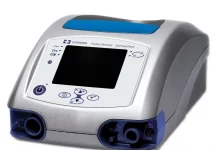The Most Common Causes of Sciatica Pain (Leg Pain). The Sciatica Pain affecting the back, hip, and outer side of the leg, caused by compression of a spinal nerve root in the lower back, often owing to degeneration of an intervertebral disk.
The sciatic nerve is a large nerve trunk formed by the union of the nerve roots of the lumbar and back of the leg to reach the toes. Sciatica is pain irradiation of these structures from the lower back long leg and foot depending on which nerve root is damage or nerve compression.
The origin of the sciatic nerve, which has a motor and sensory function, is in the lumbar vertebral roots (L1, L2, L3, L4 and L5) and the first sacral (S1) through the foramina between vertebrae, then passes through the pelvis and branching down the leg to the foot and toes.
Dr. Rafael Gonzalez Diaz, president of the Spanish Society of Spine (GEER) explains that the pain is a first demonstration that there is something that is pressing sciatic and single nerve when the involvement is more important results a loss of strength and sensitivity.
Dr. Gonzalez Diaz Infosalus unveils the most common reasons for sciatica pain:
1. Herniated Disc: Results from the output of the disc material (nucleus pulposus) which compresses a nerve root giving rise to a pain that part of the territory of that root. It is more common in the L4 and L5 or S1. The low pain from these locations through the side and back of the leg to the ankle or toes.
2. Narrowing of the Spinal Canal: The most common reason is a degenerative osteoarthritis associated with aging that causes the spinal canal and foramina between vertebrae where they exit the nerves and causes a loss of feeling and numbness of progressively narrowing legs. Pain and numbness down the back side of the leg to the foot. In typical cases patients are able to walk a few meters in the most serious cases and need to sit up and lean forward to relieve symptoms.
3. Degeneration of a Vertebral Disc: May be due to a hernia or not, with age disc wear occurs and there are people who are genetically predisposed. Need not produce symptoms. “From age 50 if all of us pass by an MRI this condition would be detectable in 50% of the general population,” says the doctor. A constitutional grounds and wear and tear of age can join other causes such as repetition microtrauma sports or repetitive work.
4. Spondylolisthesis is a deviation of one vertebra over another by a defect or ‘split’ in a part of the vertebrae or by a degenerative process or otherwise in the vertebrae that causes one vertebra over another imprisoning slide and angering the sciatic nerve.
5. Pyramidal Syndrome: A muscle in the hip area that falls, trauma or ‘culadas’ causes the sciatic nerve to thicken and irritated as it passes through the hip and pain down the back leg and simulates an injury L5 root. The treatment is usually postural re-education and physiotherapy.
6. Tumors or Infections: When produced in the territory of the spine may occur pain radiating down the leg. “Symptoms have to be much more aware of these possible causes serious though rare. As weight loss or pain at rest and night should warn us that something is not right,” says the specialist.
DIFFERENTIAL DIAGNOSIS AND WARNING SIGNS
On the differential diagnosis Dr. Gonzalez Diaz says “as said Dr. Gregorio Maranon, the best therapeutic weapon is the chair. You have to ask and explore the patient. The clinical information guides us towards a cause, its origin, the area involving pain after proper anamnesis can be further tests to refine the diagnosis that can range from a simple traditional x-ray to an MRI. “
For the doctor, most sciaticas resolve themselves in three to four weeks with little anti-inflammatory drugs and some rest before alarm is better to establish a gentle treatment to see how the condition. “Prescribe a resonance without giving time to a favorable evolution can lead to create in the patient greater concern to clarify the situation,” said the physician.
However, the doctor notes that this provided there are no warning signs such as loss of strength or tenderness, night pain at rest or constant, weight loss or fever. To present these symptoms involvement may be due to a herniated large or even an infection or tumor.
GENERAL RECOMMENDATIONS
The president of the GEER points to several key aspects of the management and resolution of sciatica pain:
1. Make exercise to maintain good physical tone, which involves performing aerobic exercise regularly.
2. If it is a known and repetition pain, the person usually know how to treat and regulate the problem but always keep in mind that there are no warning signs that indicate the need to seek medical advice.
3. If this is first time that occurs and no warning signs general treatment recommendation is to keep a relative rest for 48 hours and first-generation painkillers like acetaminophen or ibuprofen can be used.
4. If time passes and the pain does not cover then you should need to go to the doctor to make a diagnosis and institute appropriate treatment.



